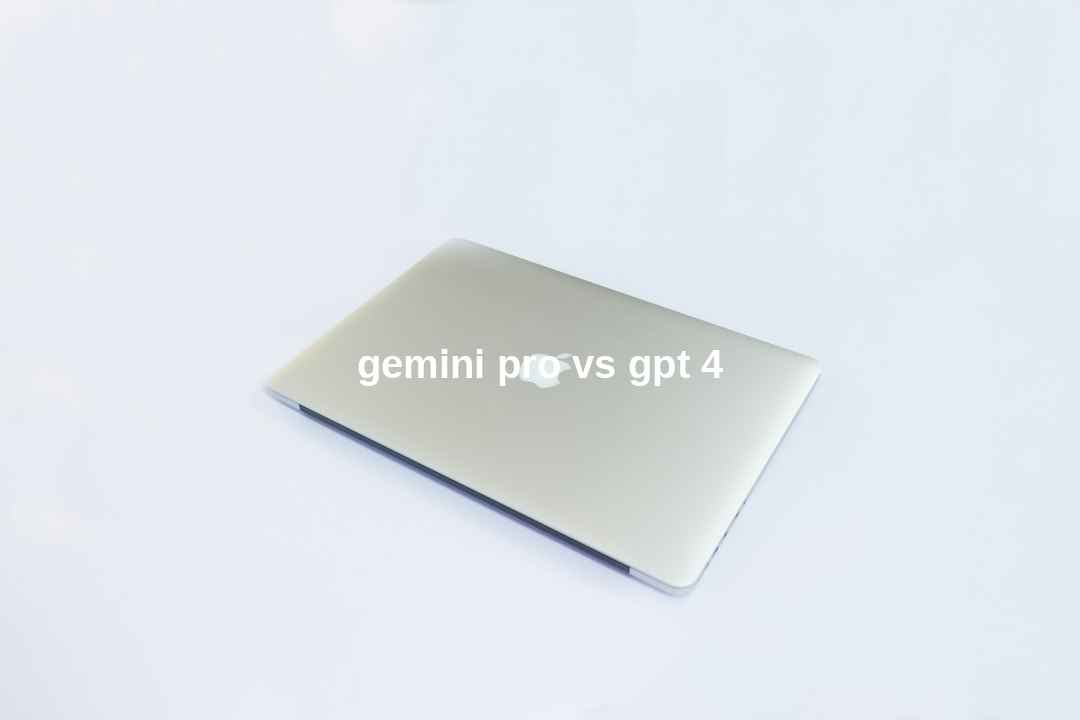Introduction:
As the artificial intelligence landscape continues to evolve at a rapid pace, some of the most significant developments come in the form of advanced language models that are transforming how machines understand and generate human language. In particular, the rivalry between Gemini Pro and GPT-4 has emerged as a key battleground for AI supremacy, with each model boasting its unique capabilities and use cases. These two titans of the AI world have sparked a great deal of interest within the tech community, as developers, researchers, and businesses alike seek to understand their strengths, weaknesses, and potential applications. This leads us straight into an in-depth analysis of these sophisticated vision-language models.
| Feature | Gemini Pro | GPT-4 |
|---|---|---|
| Release Date | ||
| Developer | OpenAI | |
| Language Understanding | Advanced Deep Learning | |
| Applications | Text Generation, Translation, Conversational AI, etc. |
Deciphering the AI Titans: An In-Depth Analysis of Vision-Language Models
Understanding the Core Technologies
Vision-language models are an exciting frontier in AI that combine the domains of computer vision and natural language processing. These models are designed to understand and generate content that spans both visual and textual elements. As they grow more sophisticated, so do their applications, expanding into areas such as image captioning, visual question answering, and even complex tasks like visual storytelling.
When examining the capabilities of Gemini Pro and GPT-4, it’s essential to delve into the specific technologies that power these models. Featuring state-of-the-art neural network architectures, both models exhibit a deep understanding of the nuances in human language and vision. They leverage vast amounts of data and intricate algorithms to interpret and generate human-like responses to a variety of inputs.
However, these models are not without their differences. For instance, one may excel in parsing the contextual subtleties found in natural language, while the other might provide more innovative solutions in integrating visual cues with textual information. The implications of these differences are profound, influencing which model is better suited for specific tasks and industries. These decisions can shape the success of AI applications in fields ranging from healthcare and education to entertainment and customer service.
The continuous advancements in these models are not only a testament to human ingenuity but also a hint at the future direction of AI developments. By decoding the intricacies of Gemini Pro and GPT-4, we can grasp a clearer understanding of where the industry is heading, and prepare ourselves for a world where AI‘s influence is steadily increasing.
Unveiling Competencies and Shortcomings: A Comparative Study

A Side-by-Side Evaluation
When assessing Gemini Pro versus GPT-4, it’s imperative to conduct a side-by-side comparison to identify the distinct competencies and shortcomings of each. Gemini Pro may be optimized for particular niches or possess proprietary technology specialized for certain tasks, while GPT-4’s strengths might lie in its versatility and large-scale language comprehension.
While Gemini Pro could excel in specialized applications, GPT-4’s robust and versatile framework allows it to perform exceptionally across a broader range of tasks, setting a benchmark in the AI field.
Identifying Use Case Scenarios
Each model may outshine the other in specific scenarios. For instance, GPT-4’s capabilities could include superior language generation, making it ideal for creative writing or dialogue systems, whereas Gemini Pro might be better at understanding and processing visual information, thus being the preferred choice for image-related tasks.
Gemini Pro may outperform in visual tasks, but GPT-4’s prowess in language generation and general AI tasks presents a strong case for its use in diverse and complex scenarios.
Task-Oriented Performance: When to Use Which Model
Assessing Performance for Specific Objectives
It’s crucial to choose the right AI model for the right job. GPT-4 could be the go-to for businesses needing advanced natural language processing, such as customer service bots or large-scale text analysis. On the other hand, organizations dealing with image recognition and processing might lean towards the capabilities of Gemini Pro.
For nuanced text analysis and generation, GPT-4 stands out, while Gemini Pro might be preferable for its handling of visual data and conceptual image understanding.
Strategic Deployment in Industry
The decision on which AI model to deploy should also consider industry-specific requirements. For instance, in the medical field, where the interpretation of visual data is crucial, Gemini Pro could potentially hold an edge. Conversely, GPT-4 might be better for legal and educational applications where comprehensive text analysis and generation are more critical.
Strategically deploying Gemini Pro in visual-data intensive industries and GPT-4 in text-heavy sectors can maximize the operational efficiency and outcome.
The Future of AI: Evolution and Emerging Trends
Anticipating Next-Generation Developments
The future of AI is a moving target, with both Gemini Pro and GPT-4 contributing to the shape of what’s to come. We can anticipate further advancements in AI that blend the boundaries between vision and language even more seamlessly, creating models that are even more capable and human-like in their interactions.
The advancements brought forth by Gemini Pro and GPT-4 signify the beginning of a new era in AI, where vision and language are integrated with unprecedented sophistication.
Emerging Trends in AI Applications
We are likely to see a surge in AI applications that are increasingly personalized and adaptive, thanks to these advanced models. From virtual assistants that understand not just what you say, but also what you show them, to educational tools that customize learning materials based on both textual and visual inputs, the potential is immense.
The emergence of highly integrated AI models like Gemini Pro and GPT-4 paves the way for personalized and multifaceted applications, revolutionizing how we interact with technology.
Moving Forward: Implications and Conclusive Insights in the AI Landscape
As we conclude our exploration of the AI titans, the dichotomy between Gemini Pro and GPT-4 offers valuable insights into the dynamic field of artificial intelligence. Both models represent the cutting-edge technology that can reshape industries, revolutionize how we interact with digital environments, and redefine our perception of machine intelligence. The inherent strengths and weaknesses of each model highlight the importance of tailored applications, where the choice of AI directly aligns with the end goals of a task or project. In essence, the intelligence and functionality brought to the table by these models underscore a significant principle in AI deployment: the right tool for the right job not only maximizes efficiency but also drives innovation.
The juxtaposition of Gemini Pro and GPT-4 illuminates a crucial narrative in the ongoing development of AI; one that underscores the need for strategic alignment between an AI’s capabilities and its intended application.
- Gemini Pro and GPT-4 are leading vision-language models with unique strengths and applications.
- Assessing the pros and cons of each model is vital for optimal task-specific performance.
- The models differ significantly in their handling of text versus visual data.
- Selecting the right AI model depends on the specific needs and goals of an industry or project.
- Technological advancements in AI continue to blend the boundaries between vision and language processing.
- New trends in AI point towards more personalized and adaptive applications.
- The future of AI promises even more sophisticated integrations of vision and language capabilities.
Frequently Asked Questions
What are the key differences between Gemini Pro and GPT-4?
The key differences between Gemini Pro and GPT-4 primarily revolve around their specializations, with Gemini Pro often being associated with stronger capabilities in integrating visual data processing, while GPT-4 is renowned for its advanced text generation and processing abilities. The specific architectures, training methods, and intended use cases can also vary significantly, making each suited to different tasks and industries.
How can I determine which AI model is more suited to my needs?
To determine which AI model is more suited to your needs, consider the nature of the tasks you are looking to perform. If your tasks revolve more around visual data interpretation—like image recognition or visual storytelling—Gemini Pro might be more appropriate. For tasks involving complex text analysis and generation, such as writing, conversation, or large-scale textual data interpretation, GPT-4 could be a better fit. Evaluate the requirements of your application in terms of language complexity, creativity, and the role of visual elements in your data.
Can GPT-4 be used for tasks involving visual data?
While GPT-4 is primarily designed for natural language processing tasks, its underlying technology may still possess some capabilities to work with visual data, especially if it’s been trained on multimodal datasets. However, for tasks that are heavily focused on image recognition or other forms of visual data analysis, a model specifically built for such purposes, like Gemini Pro, might perform better.
What are some of the industries that might benefit from using Gemini Pro?
Industries that deal with a high volume of visual data can benefit greatly from using Gemini Pro. This includes sectors such as healthcare for medical imaging, automotive for driver assistance systems, security for surveillance analysis, and any field that requires image categorization or visual quality control.
Are there tasks where Gemini Pro and GPT-4 could work together?
Yes, there are scenarios where the capabilities of Gemini Pro and GPT-4 could complement each other. For instance, in an application that requires both a deep understanding of visual content and the ability to generate descriptive narratives or responses based on those visuals, deploying both models could achieve better results than using either one alone.
What advancements might we see in future versions of these AI models?
Future versions of AI models like Gemini Pro and GPT-4 are expected to offer even more advanced integration of visual and language processing, with improvements in understanding context, nuance, and multimodal data. We might also see better energy efficiency, faster processing times, and enhanced learning algorithms that require less data to make accurate predictions or generate high-quality content.
How user-friendly are Gemini Pro and GPT-4 for those without deep technical knowledge?
Both Gemini Pro and GPT-4 have the potential to be user-friendly, particularly if they are incorporated into applications with intuitive interfaces. For end-users, interacting with these AI models can be as simple as typing a request or uploading an image. However, setting up and customizing these models for specific applications might still require a certain level of technical expertise.


